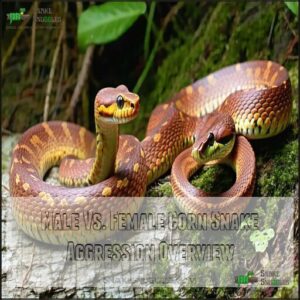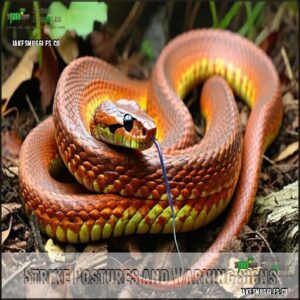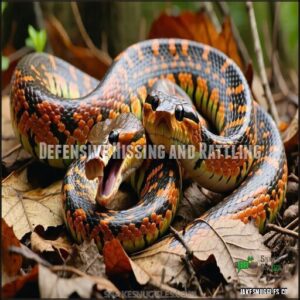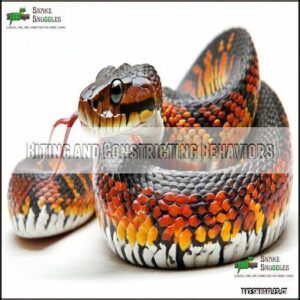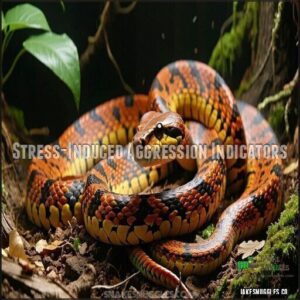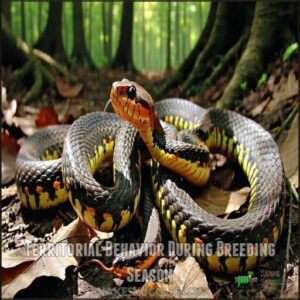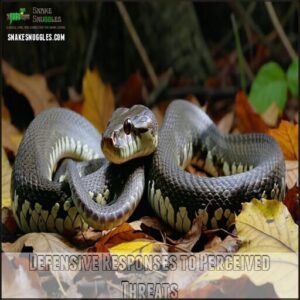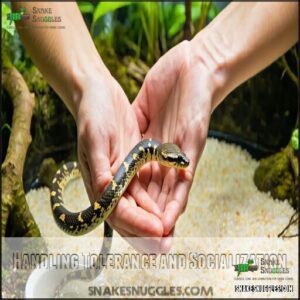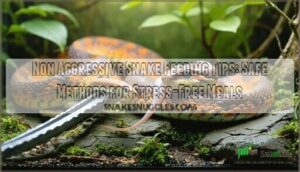This site is supported by our readers. We may earn a commission, at no cost to you, if you purchase through links.

However, males can get feisty during breeding season, especially around other males, as they compete for dominance. Females, on the other hand, might get defensive when protecting their eggs or after laying them.
Most corn snakes, regardless of sex, are known for their docile behavior and rarely show aggression unless they’re scared or stressed. Providing proper care, handling them calmly, and understanding their triggers can go a long way in keeping your snake relaxed.
Curious about handling tips? Keep reading to learn more about handling your corn snake.
Table Of Contents
- Key Takeaways
- Male Vs. Female Corn Snake Aggression Overview
- Identifying Aggressive Behaviors in Corn Snakes
- Factors Affecting Corn Snake Aggression Levels
- Male Corn Snake Aggression Characteristics
- Female Corn Snake Aggression Patterns
- Managing Aggression in Male and Female Corn Snakes
- Frequently Asked Questions (FAQs)
- Are male & female corn snakes more aggressive?
- Why are corn snakes more aggressive when they shed?
- Do corn snakes have a bigger appetite than males?
- Do corn snakes live longer than males?
- Is there a difference between male and female corn snakes?
- Do corn snakes have different temperaments?
- Which gender of snake is more aggressive?
- What’s the difference between male and female corn snakes?
- Why is my corn snake being aggressive?
- Do male or female corn snakes live longer?
- Conclusion
Key Takeaways
- Male corn snakes can be more aggressive during breeding season due to testosterone, showing territorial and competitive behaviors.
- Females are generally calmer but may become defensive when protecting eggs or after laying them.
- Stress factors like improper enclosure setups, handling techniques, or environmental changes can trigger aggression in both sexes.
- Regular handling, a proper stress-free habitat, and understanding of hormonal or seasonal behaviors help reduce aggression in both male and female corn snakes.
Male Vs. Female Corn Snake Aggression Overview
In the context of aggression, male and female corn snakes show some noticeable differences influenced by hormones, temperament, and environmental factors.
Understanding these distinctions can help you handle each snake more effectively and reduce stress for both you and your pet, which is crucial for a healthy and stress-free relationship.
Knowing your corn snake’s behavior unlocks trust, eases handling, and creates a calm, stress-free bond for you and your pet.
Natural Temperament Differences
Corn snakes show fascinating personality differences, with temperament influenced more by individual variation than by whether they’re male or female.
Still, sex temperament patterns exist. Male corn snakes are typically more active and curious, especially during the breeding season, while females are calmer and more docile. Females may, however, turn defensive after laying eggs. It’s like comparing a restless explorer to a laid-back caretaker.
Here’s a quick breakdown to compare temperament traits:
| Trait | Male Corn Snake | Female Corn Snake |
|---|---|---|
| Activity Level | High and exploratory | Calm and steady |
| Aggression Timing | Breeding season-driven | Post-egg-laying defense |
| Protective Behavior | Minimal | Egg-focused |
| Mood Stability | Seasonal variation | Consistently docile |
Genetic Factors Influencing Aggression
Genetics plays a key role in shaping temperament, giving some corn snakes inherited predispositions that influence behavior.
Male vs. female aggression often stems from sex-specific aggression genes and hormonal effects. Testosterone fuels male corn snake competition, making them bold and territorial, especially in breeding seasons. Meanwhile, estrogen drives females’ defensive instincts after egg-laying, giving them a more cautious edge.
Selective breeding has further refined these tendencies, creating lineages with predictable behavioral patterns. For instance, some color morphs, like vivid-patterned snakes, may align with more assertive or aggressive traits.
Here’s a quick breakdown:
| Genetic Factor | Males | Females |
|---|---|---|
| Aggression Genes | Competitive traits | Protective instincts |
| Territorial Behavior | Pronounced | Cautious |
| Seasonal Aggression | Breeding-focused | Egg-protection phases |
| Natural Disposition | Exploratory, assertive | Calm, defensive |
| Lineage Tendencies | Bold patterns | Subdued instincts |
Understanding these influences helps tailor their care.
Environmental Influences on Aggression
A peaceful snake starts with the right environment.
Small changes in the way you set up your snake’s space can have a big impact on stress levels and aggression.
A stress-free habitat with proper temperature control (75–85°F), manageable noise levels, and good enclosure size keeps your snake calm.
Giving your pet opportunities for habitat enrichment, like climbing structures, also helps.
Overcrowding, loud surroundings, or improper care leads to defensive behavior and increases snake aggression causes.
Here’s an overview of environmental stressors and solutions:
| Factor | Impact on Aggression | Solution |
|---|---|---|
| Enclosure Size | Prevents territorial behavior | 20–40 gallons or more |
| Temperature | Reduces stress spikes | Maintain gradient 75–85°F |
| Noise Levels | Lowers defensive reactions | Place in quiet room |
| Enrichment | Engages instincts, reduces boredom | Add climbing areas and spaces |
A proper snake enclosure reduces aggression, making handling sessions easier!
Hormonal Impacts on Behavior
Hormones are behind many mood swings you’ll notice in snakes.
Testosterone levels in males spike during the breeding season, fueling territorial behaviors and male vs female aggression.
Females, on the other hand, experience estrogen effects, especially post-laying behavior, leading to defensive mood swings.
Here’s a quick comparison:
| Hormone | Effects on Males | Effects on Females |
|---|---|---|
| Testosterone | Territorial aggression | N/A |
| Estrogen | N/A | Defensive post-laying behavior |
| Hormone Fluctuations | Increased aggression during mating | Mood swings tied to reproduction |
Recognizing hormone-driven behaviors helps manage aggression, ensuring your pet stays calm and content year-round.
Captive corn snakes often display a docile and even-tempered nature when regularly handled.
Identifying Aggressive Behaviors in Corn Snakes
When a corn snake feels threatened, it might show specific warning signs like coiling into an S-shape, puffing up, or hissing.
Understanding these signals helps you handle them safely and minimize stress for both you and your snake.
Strike Postures and Warning Signs
When your corn snake feels threatened, its body language will warn you before a bite.
Recognizing these signals helps prevent misunderstandings.
- S-shaped coils: Your snake curls its neck like a spring, preparing for a possible strike. This posture says, “Stay back!”
- Body puffing: Flattening and expanding its body is your snake’s way of looking bigger to scare threats. Think of it as a reptile’s version of flexing.
- Head movement: Rapid, jerky head bobs show heightened alertness and discomfort.
These behaviors aren’t just aggression—they’re self-defense. By watching for strike postures, you’ll foster safer, more confident handling and a peaceful bond with your snake.
Defensive Hissing and Rattling
When a snake feels threatened, it uses hissing and rattling as warning signals. For corn snakes, these defensive behaviors are common ways to say, “Back off!” The Hissing Frequency and Rattling Intensity often depend on the situation.
Notably, tail vibrations mimic rattlesnakes—a clever Mimicry Defense designed to deter predators.
| Behavior | Purpose | Frequency in Adults | Auditory Range |
|---|---|---|---|
| Loud hissing | Warns predators | High | Easily heard indoors |
| Tail rattling | Mimics rattlesnake | Moderate | Varies with vibration |
| Coiling tightly | Prepares for defense | Moderate | Silent, visual warning |
| Stiffened body | Signals discomfort | Common | Physical alert only |
Respect these signals. Handling a male corn snake or female corn snake calmly reduces unnecessary aggression. Snake temperaments improve over time with trust-building, but defensive behavior is an evolutionary purpose to prevent harm.
Biting and Constricting Behaviors
When hissing fails to deter, snakes may bite or constrict, leveraging their bite force and constriction strength as deterrents.
Corn snakes, though non-venomous, bite instinctively if triggered.
Minimize snake bites by:
- Avoiding fast motions, which can activate their aggression triggers.
- Washing hands thoroughly, as prey-like scents may confuse them.
- Supporting their body gently to reduce handling risks.
Bites from a baby snake aren’t serious, but surprise and discomfort are common.
Both male corn snakes and female corn snakes may react this way depending on prey size or stress.
Respect guarantees calmer handling!
Stress-Induced Aggression Indicators
It’s easy to tell when stress hits your snake.
Stress shows in restless movements, tail whipping, or hissing—your snake’s way of saying, “I need space and calm.”
Tail whipping, restless movements, and defensive behavior are clear signs of stress-induced aggression.
Aggression triggers like sudden noises, cramped enclosures, or handling aggression from poor technique can make things worse.
A calm setup—stable temperatures, quiet surroundings—can help, think of it like creating a zen zone to keep your snake at ease, which can significantly reduce defensive behavior.
Territorial Displays and Dominance
Territoriality in corn snakes is a mix of instinct and strategy, revealing fascinating behaviors. When claiming their space, they don’t just sit idle—they put on a show. Males, especially during breeding season, take the lead with bold combat dances and posturing displays, where they puff up or coil to appear bigger.
These movements establish a dominance hierarchy without full-blown fights. Females aren’t pushovers either. They defend their turf through calculated spatial control, using body positioning and subtle movements to avoid unnecessary confrontations.
Both sexes communicate non-verbally, warning rivals with a stubborn “keep out” attitude. Instead of just fighting outright, snakes rely on a clever mix of intimidation and resource guarding to claim territory.
- Combat dances resolve disputes without injury.
- Posturing displays warn intruders.
- Non-verbal signals emphasize dominance over rivals.
Factors Affecting Corn Snake Aggression Levels
You’ve probably noticed that corn snake aggression isn’t just random—it’s influenced by several key factors.
From handling routines to enclosure conditions, understanding these can help you reduce stress and keep your snake calm.
Handling Frequency and Techniques
Gentle handling builds trust and minimizes corn snake aggression. Start by supporting them fully and using slow movements. A male corn snake may require hook training to ease initial handling. Watch for coiling or striking before continuing; this helps you read signals better.
Handle 2-3 times weekly for 5-10 minutes.
| Frequency | Techniques | Tips |
|---|---|---|
| 2-3 times weekly | Gradual introduction | Avoid shedding periods |
| 5-10 minutes/session | Secure grip | Use steady, gentle touch |
| During calm periods | Read signals carefully | Handle calmly and slowly |
| Build consistency | Hook training if needed | Always support the body |
Consistency is key. Over time, even a nervous female corn snake becomes more relaxed with patient handling.
Enclosure Size and Setup
A corn snake’s enclosure size directly affects its behavior.
Adults need space requirements of 20-40 gallons to minimize stress.
Temperature gradients between 75-85°F, paired with proper hiding spots, create a calming habitat.
Add climbing enrichment like branches to satisfy instincts.
Good snake enclosure designs also mean secure lids—corn snakes are skilled escape artists.
To find the right setup, you may want to browse a corn snake enclosure online.
Use soft substrates like aspen shavings to mimic their natural environment.
Without these snake enclosure requirements, aggression can spike.
- Imagine your snake peacefully exploring, safely tucked away in a perfect hiding spot!
Feeding Habits and Schedules
Feeding plays a big role in managing corn snake aggression.
Stick to regular schedules to curb stress and keep behaviors calm:
| Age | Feeding Frequency | Prey Size | Tips |
|---|---|---|---|
| Hatchlings | Every 5-7 days | Pinky mice | Small portions avoid regurgitation. |
| Juveniles | Every 7-10 days | Fuzzy/small mice | Steady meals stabilize moods. |
| Adults | Every 10-14 days | Adult mice | Manageable sizes prevent stress. |
Always choose frozen over live when possible to prevent injuries.
A diet with variety guarantees healthy, happy snakes.
Social Interactions With Other Snakes
Corn snakes are solitary species, so cohabitation risks often result in stress or snake aggression.
Male corn snakes engage in dominance displays, wrestling for territory, while females stay territorial and may spar occasionally. Sharing space can disrupt snake territoriality and lead to more intense aggression.
- Keep snakes separate: It avoids dominance struggles and cannibalism potential.
- Understand sex differences: Males fight more during breeding, females defend space consistently.
- Monitor juveniles closely: Even young snakes can show aggression during interactions.
Seasonal Changes and Breeding Cycles
Breeding seasons bring out the competitive side of male corn snakes as they ramp up their dominance displays and territorial aggression, especially against other males.
Hormonal surges during mating season make them more active and unpredictable. Female corn snakes, on the other hand, shift to more defensive behaviors post-ovulation, particularly during egg-laying.
Temperature influence, shedding cycles, and even brumation behaviors can reset these patterns seasonally. Learning to spot these changes helps reduce snake aggression during mating.
By understanding these seasonal shifts, you can handle your snakes more safely and keep their breeding stages stress-free and balanced. Successful breeders often induce breeding through careful brumation techniques, utilizing careful methods to ensure a healthy outcome, which is crucial for successful breeding.
Male Corn Snake Aggression Characteristics
Male corn snakes are often more aggressive than females, especially during breeding season when testosterone levels peak.
Their aggression is usually directed at other males but can include quick defensive responses if they feel threatened.
Territorial Behavior During Breeding Season
Territorial behavior in male corn snakes peaks during mating season, driven by hormonal influences and resource competition.
Their typically calm nature shifts to focused determination as they seek mates and assert dominance, often ignoring food altogether.
You’ll notice these behaviors:
- Territorial marking: Males establish boundaries using scent trails.
- Male combat displays: Non-violent but energetic wrestling shows dominance.
- Mating rituals: Males track and guard females persistently.
- Aggressive tendencies: Hormones heighten snake aggression during mating season.
This temporary transformation is nature’s way of prioritizing reproduction—just a seasonal quirk of male motivation!
Competitive Aggression Towards Other Males
When it’s breeding season, male corn snakes ramp up their aggression toward each other in what can only be called nature’s version of colorful combat dances.
These competitive encounters often involve dramatic dominance displays, including head bobbing, tail vibrations, and even wrestling to establish clear hierarchies. It’s all about resource guarding, with each male staking claim to territory and potential mates.
While these battles may look intense, they’re usually low on injury risk, thanks to the snakes’ instinct to avoid serious harm. Instead, they focus on forcing their rivals to back down.
Curious about the key behaviors? Here’s a breakdown:
| Behavior | Purpose | Frequency |
|---|---|---|
| Head Raising | Assert dominance | High |
| Tail Vibrations | Back-off warning | Moderate |
| Physical Wrestling | Overpower the opponent | Moderate |
| Slow Approach | Intimidation tactic | Frequent |
| Freeze Stance | Gauge opponent’s intent | Occasional |
These behaviors guarantee only the fittest pass on their genes, showcasing the strategic side of snake aggression, and highlighting the importance of competitive encounters in the natural world.
Defensive Responses to Perceived Threats
When feeling threatened, male corn snakes rely on impressive defensive mechanisms.
Their aggression triggers may include stress indicators or environmental triggers like sudden handling or predators.
They’ve got quite a repertoire of moves to protect themselves:
- Flatten their body to seem bigger and scarier.
- Shake their tail to imitate a rattlesnake—a clever bluff!
- Freeze, thinking, “If I don’t move, I’m invisible.”
- Strike quickly if pushed too far.
- Coil tightly, forming a protective fortress.
These behaviors reflect their natural instincts for survival.
Handling Tolerance and Socialization
Early socialization and handling techniques shape a male corn snake’s temperament.
Support its body fully, use slow movements, and handle regularly to reduce stress.
Positive reinforcement builds trust, making handling easier over time.
Each snake’s individual temperament matters, so stay patient.
With careful handling and consistent socialization, both male and female corn snakes can become calm, manageable companions, even for new snake keepers.
Proper enclosure size is also key to their mood.
Female Corn Snake Aggression Patterns
You’ll notice female corn snakes are generally calm, but their behavior can shift under certain conditions. They may become defensive after laying eggs or when dealing with environmental stress.
Protective Behavior During Egg-Laying
When it’s time for egg-laying, female corn snakes become fiercely protective, showcasing strong maternal instincts.
Their behavior is driven by hormonal influences and a natural focus on clutch protection.
You’ll notice clear signs of nesting aggression:
- Post-Laying Defense: Coiling around eggs, shielding them from danger.
- Egg Defense Behavior: Seeking secluded, predator-free spots for nesting.
- Maternal Care Signals: Hissing or striking if approached.
- Alertness: Staying vigilant near their clutch to guarantee safety.
These instincts make snake aggression over eggs highly predictable and natural.
Hormonal Fluctuations and Mood Changes
During the breeding season, hormonal fluctuations like testosterone’s role and estrogen’s influence can cause mood swings in a female corn snake.
These shifts might make her more defensive, especially post-laying behavior.
Understanding corn snake body language can help discern these subtle cues.
To help, give her a low-stress space with good hiding spots and limited handling.
Here’s a quick guide:
| Trigger | Impact on Mood | Solution | Time Focus | Male V. Female Effect |
|---|
Defensive Reactions to Environmental Stressors
Environmental stress can make any snake uneasy, but female corn snakes may particularly show defensive reactions when their comfort is disrupted.
A calm setup helps reduce snake aggression, especially during sensitive periods.
Stress triggers often include:
- Enclosure Overcrowding: A tank shared with others or too small increases tension.
- Temperature Extremes: Even minor swings outside the 75–85°F range can upset natural rhythms.
- Noisy Environments: Loud sounds or vibrations near the setup can leave snakes jumpy.
- Poor Handling: Rough movements or lack of care during handling rattles their trust.
When stress hits, watch for behaviors like tail whipping or S-shaped strikes.
Providing enrichment and a serene environment is the best way to soothe these instincts naturally.
Long-Term Behavioral Changes After Breeding
How does breeding impact a female corn snake’s temperament? After egg-laying, she might hide more, refuse meals, or become defensive. These behaviors stem from hormonal fluctuations as her body recovers.
Here’s a quick overview of behavioral changes:
| Behavior | Cause | Duration |
|---|---|---|
| Increased hiding | Stress recovery | 2-4 weeks |
| Meal refusals | Hormonal shift | 1-2 weeks |
| Defensive reactions | Post-breeding stress | Temporary |
Patience is key. Make certain a calm, stress-free enclosure to help her return to her usual self quickly.
Managing Aggression in Male and Female Corn Snakes
You can manage aggression in corn snakes by understanding their triggers and creating a calm environment.
Consistent handling, proper enclosure setups, and addressing specific behaviors for males and females will help minimize stress and keep your snake comfortable.
Proper Handling Techniques for Both Sexes
Handling corn snakes properly reduces stress and minimizes corn snake aggression. Use safe lifting by supporting the snake’s body securely but gently. Avoid sudden moves that may startle a male or female corn snake.
Practice gradual acclimation by starting with short handling sessions.
Follow these techniques:
- Use gentle restraint—never grip too tightly.
- Try hook training for nervous or defensive snakes. A useful tool is a specialized snake hook for handling.
- Watch for reading cues like tongue flicking or coiling.
- Stay calm—your confidence reassures a tense snake.
With patience, snake handling becomes easier and safer.
Creating Stress-Free Environments
Creating a peaceful habitat can substantially reduce corn snake aggression and improve their overall temperament.
A well-planned setup helps both male and female corn snakes feel at ease. Here’s how to tailor your enclosure for stress-free living:
- Spacious Housing — Provide ample room to prevent overcrowding and promote natural movement.
- Temperature Regulation — Keep the enclosure at 75–85°F to match your snake’s ideal needs.
- Enclosure Enrichment — Add branches, rocks, and hiding spots.
These elements encourage instinctive behavior while minimizing stressors. A proper setup requires a suitable snake habitat.
Consistent care makes all the difference, helping your corn snake thrive in a calm environment.
Behavioral Training and Desensitization Methods
Behavioral training is key to taming aggression in both male and female corn snakes.
Think of it as teaching them to trust you, one gentle step at a time. Start small with handling sessions lasting no more than five minutes, gradually increasing as they get comfortable.
Habituation techniques, like introducing them to new environments slowly, help reduce stressors that fuel aggression. Stay calm and avoid sudden movements—your snake will appreciate predictable, safe handling.
Use positive reinforcement to associate handling with a stress-free experience. For example:
- Use target training to help them recognize feeding or interactions.
- Handle gently but confidently to build trust.
- Train consistently to improve their overall snake temperament.
Addressing Sex-Specific Aggression Triggers
Sometimes, corn snake aggression boils down to understanding their natural instincts and triggers.
Male corn snakes often show territorial aggression during breeding season.
They might get restless, skip meals, or act combative.
To manage this, focus on Handling Techniques and Enclosure Design.
Provide plenty of climbing areas and hides while limiting handling during this time to ease their stress.
Female corn snakes, on the other hand, tend to become defensive after laying eggs.
This behavior is heavily influenced by hormonal changes.
A peaceful, secluded spot can help her feel protected, reducing her need to act out.
Adjusting Feeding Schedules and ensuring a stress-free setup are key here.
Recognizing snake sex differences is essential for addressing sex-specific aggression.
Respect their instincts by tailoring care to their needs, and you’ll enjoy a calmer, happier snake with better handling and a stress-free environment.
Professional Intervention for Persistent Aggression
If your corn snake’s aggression isn’t improving, it’s time to bring in professionals like veterinarian consultations or expert reptile handlers.
They can pinpoint what’s causing the behavior and guide you through advanced training or even behavioral modification. Persistent issues might stem from hidden aggression triggers.
Here’s what experts typically do:
- Health Check: Discovering if illness or injury is fueling aggression.
- Habitat Audit: Spotting stress factors like overcrowding or temperature issues.
- Behavioral Training: Teaching handling techniques or, if needed, considering medication options.
With professional intervention, aggression management becomes less stressful—for you and your snake!
Frequently Asked Questions (FAQs)
Are male & female corn snakes more aggressive?
Male corn snakes can be feistier, especially during breeding season, fueled by testosterone.
Females are usually calmer but may get defensive after laying eggs.
Individual personality and care matter more than gender for aggression levels.
Why are corn snakes more aggressive when they shed?
Snakes become more aggressive when shedding because their vision blurs, making them feel vulnerable and defensive.
During this time, their thinner skin adds to discomfort, so handling them less reduces their stress-related aggression.
Do corn snakes have a bigger appetite than males?
Think of your corn snake as a culinary critic—females often have bigger appetites due to their need to support reproduction.
They might eat more frequently, especially when building energy reserves for egg production.
Do corn snakes live longer than males?
Male corn snakes generally live as long as females if cared for properly, averaging 10-15 years in captivity.
Lifespan differences don’t depend on sex but rather diet, habitat conditions, and overall care quality.
Is there a difference between male and female corn snakes?
It’s like comparing apples to oranges—male and female corn snakes differ subtly.
Males are usually smaller, with longer tails and more energy during breeding seasons.
Females grow larger, are bulkier, and generally more laid-back, while males have more energy, which is a key distinction in their behavior and physiology, particularly during breeding seasons.
Do corn snakes have different temperaments?
Corn snakes have varied temperaments that depend more on personality than sex.
Some are naturally docile, while others can be feisty.
Regular handling, stress-free habitats, and understanding their quirks help create a calmer, happier snake.
Which gender of snake is more aggressive?
Imagine two rivals in a boxing ring—male corn snakes are more aggressive, especially during breeding season, due to testosterone-fueled competitiveness.
Females, however, tend to stay calmer, only showing defensiveness after laying eggs.
What’s the difference between male and female corn snakes?
Male corn snakes are smaller, slender, and more agile, often more active and territorial during breeding season.
Females are larger, heavier, with shorter tails, typically calmer but may become defensive after laying eggs.
Why is my corn snake being aggressive?
Think of your snake’s aggression as its way of waving a red flag.
Stress, shedding, hunger, or hormonal changes during breeding season can spark this behavior.
Make certain proper handling, space, and temperature to calm it down, considering hormonal changes can significantly impact your snake’s behavior.
Do male or female corn snakes live longer?
Both male and female corn snakes typically have similar lifespans, averaging 15-20 years in captivity with proper care.
Longevity depends more on factors like diet, habitat conditions, and overall health rather than their sex.
Conclusion
Turns out, arguing over whether male or female corn snakes are more aggressive is like debating which sibling hogs the remote—context matters.
Males may get territorial during breeding, while females defend their eggs passionately.
Both usually stay docile if you handle them gently and keep their environment stress-free.
Recognizing triggers, like season or enclosure setup, helps manage their temperament.
So, focus on care and understanding rather than labeling one sex as the “troublemaker”!
- https://www.cell.com/current-biology/fulltext/S0960-9822(15)00218-3?_returnURL=https%3A%2F%2Flinkinghub.elsevier.com%2Fretrieve%2Fpii%2FS0960982215002183%3Fshowall%3Dtrue
- https://pdfs.semanticscholar.org/a479/1ccadeacee91b8ede173b4f08d9ddb618444.pdf
- https://journals.plos.org/plosone/article?id=10.1371/journal.pone.0086208

